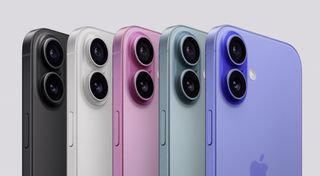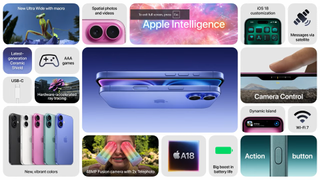
The iPhone 16 is finally here, with Apple having debuted its new base model alongside the iPhone 16 Plus, iPhone 16 Pro, and iPhone 16 Pro Max at its latest Apple event on September 9.
For an early look at the new phones, check out our hands-on iPhone 16 review, hands-on iPhone 16 Plus review, hands-on iPhone 16 Pro review, and hands-on iPhone 16 Pro Max review.
All four devices look set to rank among the best iPhones ever, offering new buttons, redesigned cameras, and Apple Intelligence features that could also make them some of the best AI phones of 2024 (as Tim Cook noted on stage, they're the "first iPhones designed from the ground up for Apple Intelligence").
Below, we've rounded up everything you need to know about the iPhone 16, from its price and release date to its new hardware and software.
iPhone 16: key information
- The iPhone 16 will begin shipping on September 20
- Starts at $799 / £799 / AU$1,399
- It inherits the Action button from the iPhone 15 Pro
- ... and gets a new dedicated Camera Control button
- Camera Control can be used to instantly learn about your surroundings
- The iPhone 16 uses the new A18 chipset
- It comes with up to 512GB of storage
- ... and a reported 8GB of RAM to power Apple Intelligence
- Apple Intelligence features will begin rolling out in October
- The iPhone 16's cameras are aligned vertically for spatial video capture
- It ships with iOS 18
- The iPhone 16 comes in Ultramarine, Teal, Pink, White, and Black
- The iPhone 16 charges at up to 45W, which is much faster than the iPhone 15
iPhone 16: price, release date and preorders
- Starts at $799 / £799 / AU$1,399
- Pre-orders open on September 13, and shipping begins on September 20
The iPhone 16 was announced at Apple's 'It's Glowtime' event on Monday, September 9. iPhone 16 preorders begin on Friday, September 9, and the phone will hit store shelves on Friday, September 20. For a look at the early deals, check our our dedicated iPhone 16 deals page.
The iPhone 16 starts at $799 / £799 / AU$1,399 for the model with 128GB of storage, with that price rising to $899 / £899 / AU$1,599 for the model with 256GB of storage and $1,099 / £1,099 / AU$1,949 for the model with 512GB of storage.
For reference, those are the same prices as we saw for the iPhone 15 at launch in the US and UK. In Australia, the iPhone 16 is actually AU$100 cheaper than the iPhone 15. Full iPhone 16 pricing can be found below.
Get daily insight, inspiration and deals in your inbox
Sign up for breaking news, reviews, opinion, top tech deals, and more.
| Storage | US price | UK price | AU price |
| 128GB | $799 | £799 | AU$1,399 |
| 256GB | $899 | £899 | AU$1,599 |
| 512GB | $1,099 | £1,099 | AU$1,949 |
iPhone 16 specs
Below, we've detailed the key iPhone 16 specs.
| iPhone 16 | |
|---|---|
| Dimensions: | 147.6 x 71.6 x 7.8mm |
| Weight: | 170g |
| Display: | 6.1-inch OLED |
| Resolution: | 2556 x 1179 pixels |
| Refresh rate: | 60Hz |
| Chipset: | A18 |
| Rear cameras: | 48MP main (26 mm, ƒ/1.6), 12MP ultrawide (13 mm, ƒ/2.2) |
| Front camera: | 12MP (ƒ/1.9) |
| Storage: | 128GB, 256GB, 512GB |
iPhone 16 colors
The confirmed iPhone 16 colors are Ultramarine, Teal, Pink, White, and Black.
For reference, the iPhone 15 launched in Yellow, Blue, Pink, Green, and Black, so Apple has swapped out three shades for new colors this year.
iPhone 16: new features
- New Action Button
- New Camera Control button
- New A18 chipset
- Will get Apple Intelligence features in October
- Vertical cameras for spatial video capture
Save for its vertically aligned rear camera lenses (which have been re-arranged to allow for spatial video capture) and the additions of both the iPhone 15 Pro's multi-purpose Action button and an all-new Camera Control button, the standard iPhone 16 looks a whole lot like the standard iPhone 15.
Of course, those three physical upgrades are not inconsequential – they're most definitely all welcome, especially the new Camera Control feature, which we'll dive into below – but alone, they're not enough of a reason to upgrade. The real exciting improvements for the iPhone 16 come under the hood.
For starters, Apple's latest standard model is powered by the new A18 chipset, which marks a two-step jump over the A16 Bionic chipset inside the iPhone 15 and iPhone 15 Plus. That's a big deal, since Apple almost always slaps its previous-generation top-end chipsets on its new standard models; instead, this year, the iPhone 16 gets an exclusive chipset (well, alongside the iPhone 16 Plus).
That said, an early benchmark suggests the A18 chipset might not quite provide as much of a boost in power as we'd hoped.
It will however boost your privacy, as we've learned that it includes a way to stop malicious apps from disabling the camera and microphone indicators.
We can also assume that the iPhone 16 comes with 8GB of RAM, up from 6GB of RAM on the iPhone 15. Why? Well, Apple actually hasn't disclosed the new phone's RAM capacity, but we do know that at least 8GB of RAM is needed to power Apple Intelligence features, which we know the iPhone 16 has (albeit not until October, when Apple Intelligence will begin rolling out in beta).
Among the most exciting Apple Intelligence features on the horizon are a ChatGPT-powered Siri, text summarization, writing assistance, and generative image creation. These tools will bring the iPhone 16 in line with rival devices like the Google Pixel 9 and Samsung Galaxy S24 – in other words, Apple is no longer behind in the AI race.
Apple hasn't yet disclosed the size of the iPhone 16's battery, but we do know that the new phone offers a "big boost in battery life." Given that the iPhone 15 is rated for 20 hours of video playback, that's a promising claim.
The iPhone 16 also supports wireless MagSafe charging at up to 25W, which is almost double the previous 15W limit, and 45W wired charging, which is over 50% faster than the iPhone 15 lineup. Nice work, Apple.
But back to the Camera Control button, which is the big new physical upgrade on all of the iPhone 16 models. This physical-but-also-capacitive button sits on the right-hand side of the phone, under the power button, and doubles as a shutter release.
One press of the Camera Control button immediately initiates the camera app, another press takes a photo, while holding it down starts a video. But that's not all: rather like a touch bar, the Camera Control button also supports various gesture controls, so can zoom and adjust exposure, among other useful things, using just your finger.

As mentioned, this new Camera Control button is joined by the old multi-purpose Action button on the iPhone 16, so presumably the combination of the two features could make the new phone (or at least the iPhone 16 Pro) one of the best camera phones around.
My analysis

Axel is TechRadar's Phones Editor, and has been reviewing and writing about the best mobile devices (iPhones included) for several years. Based in the UK, he handles news and feature coverage for the phones section of the site, and regularly edits TechRadar's phones-related reviews and buying guides. You'll find Axel's byline on over 1,500 TechRadar articles.
So, should you upgrade to the iPhone 16? We're currently reviewing Apple's latest base model, but we can make some early judgments based on the key information we already know about the new phone.
The bottom line is this: the iPhone 16 is designed for those who want to access Apple Intelligence features without paying the premium demanded by the iPhone 16 Pro and iPhone 16 Pro Max (or indeed last year's iPhone 15 Pro and iPhone 15 Pro Max).
On a design level, this is a very similar phone to the iPhone 15. It's the same size, it's got similar cameras, the same screen, and although Apple is promising "big" battery life upgrades for the iPhone 16, the iPhone 15's battery is already more than decent. Sure, the addition of a Camera Control button and the Action button are welcome this year, but neither feature looks likely to be game-changing for casual buyers – especially as the iPhone 16 is still saddled with its predecessor's 60Hz refresh rate.
Instead, the iPhone 16 is all about software. Or more specifically, Apple Intelligence. Yes, the new phone's A18 chipset and presumed 8GB RAM capacity will certainly bring general performance improvements over the iPhone 15, but the latter handset is already a supremely fast phone. The iPhone 15 can't, however, access any of the Apple Intelligence features that Apple is marketing as the key selling point of its latest handsets. In truth, it feels a little harsh for Apple to have left iPhone 15 owners behind in this way – the otherwise excellent phone is only a year old, after all.
So, if you don't want to be left behind in the AI race, then the iPhone 16 may be worth picking up. However, if you're not too fussed about virtual assistance and are holding out for some more consequential iPhone design upgrades, then Apple's latest standard model doesn't look like a must-own. Stay tuned to TechRadar for our full iPhone 16 review, which we'll be publishing in the coming weeks.

Axel is TechRadar's UK-based Phones Editor, reporting on everything from the latest Apple developments to newest AI breakthroughs as part of the site's Mobile Computing vertical. Having previously written for publications including Esquire and FourFourTwo, Axel is well-versed in the applications of technology beyond the desktop, and his coverage extends from general reporting and analysis to in-depth interviews and opinion. Axel studied for a degree in English Literature at the University of Warwick before joining TechRadar in 2020, where he then earned an NCTJ qualification as part of the company’s inaugural digital training scheme.






